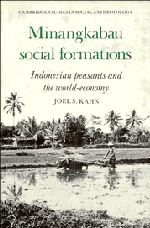Book contents
- Frontmatter
- Contents
- Lists of maps, figures and tables
- Preface
- Map
- 1 Introduction
- 2 The internal and the external in a Minangkabau village: an introduction to the world of the concrete
- 3 Adat, kinship and marriage: the constitution of the subsistence community
- 4 Agriculture and subsistence: the reproduction of the subsistence community
- 5 Commodity production in the village economy: the case of blacksmithing
- 6 Occupation, class and the peasant economy
- 7 The structure of petty commodity production
- 8 Mercantilism and the evolution of ‘traditional’ society
- 9 The emergence of petty commodity production
- 10 Conclusions: The concept of a neo-colonial social formation
- Bibliography
- Glossary of Minangkabau terms
- Index
- CAMBRIDGE STUDIES IN SOCIAL ANTHROPOLOGY
3 - Adat, kinship and marriage: the constitution of the subsistence community
Published online by Cambridge University Press: 29 September 2009
- Frontmatter
- Contents
- Lists of maps, figures and tables
- Preface
- Map
- 1 Introduction
- 2 The internal and the external in a Minangkabau village: an introduction to the world of the concrete
- 3 Adat, kinship and marriage: the constitution of the subsistence community
- 4 Agriculture and subsistence: the reproduction of the subsistence community
- 5 Commodity production in the village economy: the case of blacksmithing
- 6 Occupation, class and the peasant economy
- 7 The structure of petty commodity production
- 8 Mercantilism and the evolution of ‘traditional’ society
- 9 The emergence of petty commodity production
- 10 Conclusions: The concept of a neo-colonial social formation
- Bibliography
- Glossary of Minangkabau terms
- Index
- CAMBRIDGE STUDIES IN SOCIAL ANTHROPOLOGY
Summary
To render intelligible the concrete world of a modern Minangkabau village, to say nothing of the world of Minangkabau scholarship, is to enter the discourse on adat and matrilineal kinship. This is no less important for the world of concrete economic behaviour than for the realm of ritual. While, therefore, my main aim in the following chapters is to present a preliminary analysis of the peasant economy of the Minangkabau, in this chapter it is necessary to deal with the relations between local models of social organisation and the basic economic relations in a Minangkabau nagari.
I have pointed out that it is useful to distinguish between two sectors of the peasant economy, one concerned with subsistence production and the other with the production and distribution of commodities. Little sense can be made, at least of the former, without an understanding of the local models of kinship organisation, the relation between kinship and residence patterns and the role of adat in the system of land tenure.
Adat as conceptual system
The role of kinship and adat in defining property relations for the Minangkabau villager has changed considerably in this century. The change, as we shall see in a later chapter, is not simply one from a ‘traditional’ to a modern system. Instead, kinship has played a number of different roles in the history of Minangkabau, its form having evolved in accordance with these functional changes.
- Type
- Chapter
- Information
- Minangkabau Social FormationsIndonesian Peasants and the World-Economy, pp. 39 - 57Publisher: Cambridge University PressPrint publication year: 1980



